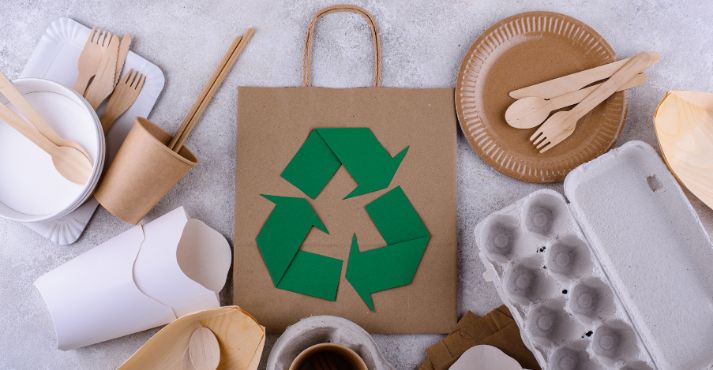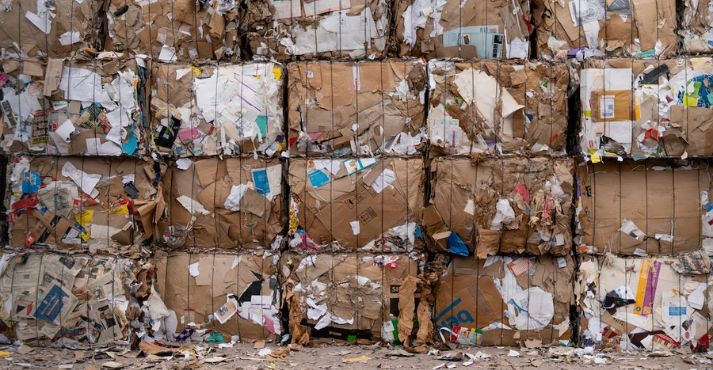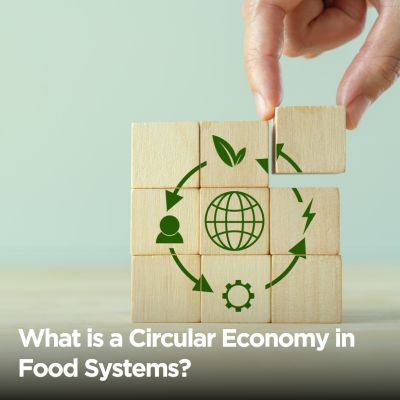In today’s environmentally conscious world, sustainable packaging has become a crucial topic of discussion.
This article delves into the concept of sustainable packaging, defining its core principles and highlighting its significance in reducing environmental impact.
Sustainable packaging, also known as eco-friendly packaging and green packaging practices, is a comprehensive approach to packaging design and materials that aligns with a commitment to environmental responsibility.
We will explore the various facets of sustainable packaging and its role in shaping a more environmentally conscious world, particularly in the B2B niche.
Defining Sustainable Packaging

Sustainable packaging is a multifaceted concept committed to minimizing the environmental footprint of packaging materials and practices.
At its core, it represents an approach to packaging design and manufacturing that prioritizes environmental responsibility, waste reduction, and resource conservation.
The critical elements of sustainable packaging encompass the following:
- Minimizing Environmental Footprint: Sustainable packaging aims to minimize the negative impact on our environment. This includes reducing greenhouse gas emissions, energy consumption, and pollution associated with the production and disposal of packaging materials.
- Waste Reduction: It involves strategies to reduce the generation of packaging waste. This can be achieved through the use of materials that are recyclable, biodegradable, or compostable. Sustainable packaging also encourages the reduction of unnecessary packaging and the use of lightweight materials.
- Resource Conservation: Sustainable packaging seeks to conserve natural resources such as water, energy, and raw materials. It often involves using renewable resources, recycled materials, and responsible sourcing practices.
- Eco-Conscious Design: Sustainable packaging is rooted in thoughtful design practices considering the entire packaging lifecycle, from production to disposal. This includes optimizing packaging for efficient transportation, reducing excess packaging, and ensuring that materials are easy to recycle or reuse.
By defining sustainable packaging in this way and emphasizing its core principles, we understand how it contributes to a more environmentally responsible approach to packaging design and manufacturing.
Key Elements of Sustainable Packaging

Material Selection
Regarding sustainable packaging, one of the fundamental considerations is the careful selection of materials.
This process involves choosing eco-friendly materials that align with sustainability goals, such as recyclable, biodegradable, or renewable resources.
The choice of materials plays a pivotal role in determining the overall sustainability of packaging practices.
- Recyclable Materials: Efficiently recyclable materials is a cornerstone of sustainable packaging. These materials, such as paper, cardboard, glass, and certain plastics, can be collected and processed into new products, reducing the strain on natural resources and minimizing waste.
- Biodegradable Materials: Biodegradable materials can break down naturally over time, returning to the environment without causing harm. Packaging made from biodegradable materials, like plant-based plastics or certain types of paper, reduces the impact of persistent waste in landfills.
- Renewable Resources: Sustainable packaging embraces materials derived from renewable resources, such as bamboo, sugarcane, or cornstarch-based plastics. These resources can be replenished, ensuring that their use is sustainable in the long term.
By emphasizing the importance of material selection in sustainable packaging, we underscore how conscious choices can significantly impact the overall environmental footprint of packaging.
Making thoughtful decisions about our materials is crucial to achieving sustainable and eco-conscious packaging practices.
Reduced Packaging Waste
Reducing packaging waste is a pivotal aspect of sustainable packaging practices. This involves employing strategies such as minimalist design, appropriate sizing, and using fewer materials in the packaging process.
This approach holds great significance in advancing sustainability goals.
- Minimalist Design: Minimalist packaging design focuses on simplicity and functionality. It aims to eliminate unnecessary elements, such as excessive layers or decorations while ensuring that the packaging serves its primary purpose. This reduction in complexity reduces waste and enhances the visual appeal of packaging.
- Appropriate Sizing: Choosing the right size for packaging is essential for waste reduction. Overly large or tiny packages can lead to inefficiencies and generate unnecessary waste. Packaging that matches the size of the product helps minimize excess materials and optimizes space during transportation.
- Using Fewer Materials: Employing fewer materials in packaging contributes significantly to sustainability. It reduces the demand for resources and lessens the environmental impact of production. This can be achieved by utilizing thinner materials or exploring innovative packaging solutions that require fewer components.
Reducing packaging waste aligns with the principles of resource efficiency and environmental responsibility.
It benefits businesses by lowering production costs and promoting a more sustainable approach to packaging, minimizing the environmental footprint, and enhancing the overall quality of packaging materials.
Energy Efficiency
In sustainable packaging, energy-efficient manufacturing processes are crucial in reducing environmental impact.
These processes focus on minimizing energy consumption while producing packaging materials and products, which, in turn, contribute to lower greenhouse gas emissions.
- Sustainable Packaging Production: Energy-efficient manufacturing practices prioritize using technologies and methods that require less energy to produce packaging materials. This can involve adopting energy-efficient machinery, optimized production schedules, and improved energy management.
- Energy-Conserving Packaging: Energy-conserving packaging extends to designing and producing packaging materials requiring less manufacturing energy. Utilizing materials with lower energy intensity, such as recycled or lightweight materials, reduces energy consumption.
- Green Manufacturing: Green manufacturing principles guide sustainable packaging processes, emphasizing energy use reduction and environmental impact. This approach often includes the integration of renewable energy sources, the implementation of energy-efficient equipment, and the adoption of eco-friendly production practices.
Reducing energy consumption in sustainable packaging lessens the environmental burden and aligns with broader resource conservation and greenhouse gas reduction goals.
Packaging contributes to a more sustainable and eco-conscious future by embracing energy-efficient manufacturing processes.
Benefits of Sustainable Packaging
Environmental Impact Reduction
Sustainable packaging brings many benefits, and one of its primary advantages is the substantial reduction in environmental impact.
This reduction manifests through several vital avenues, including a decrease in waste ending up in landfills, the conservation of natural resources, and the lowering of carbon emissions.

- Waste Reduction: Sustainable packaging practices prioritize easily recyclable, biodegradable, or compostable materials. By doing so, they significantly reduce the volume of packaging waste in landfills. This reduction lessens the burden on waste management systems and minimizes the environmental harm associated with persistent waste.
- Conservation of Natural Resources: Sustainable packaging often employs materials derived from renewable resources or uses recycled content. This approach conserves natural resources by reducing the demand for virgin materials like paper, plastics, and metals. It ensures that these resources remain available for future generations.
- Lowering Carbon Emissions: Sustainable packaging also reduces carbon emissions. Energy-efficient manufacturing processes and eco-friendly materials result in lower energy consumption and reduced greenhouse gas emissions during production. This aligns with global efforts to combat climate change.
Consumer Preference and Brand Image
Sustainability-conscious consumers are increasingly drawn to products that embrace eco-friendly packaging.
This shift in consumer preferences is significant, as it reflects a growing awareness of environmental issues and presents opportunities for businesses to enhance their brand image through sustainable packaging practices.
- Consumer Preferences: Sustainability-conscious consumers actively seek out products with eco-friendly packaging. They prioritize items that demonstrate a commitment to reducing environmental impact, such as using recyclable materials, minimizing waste, and employing energy-efficient manufacturing processes. Meeting these preferences can lead to increased consumer loyalty and brand trust.
- Sustainable Packaging Practices: Businesses that adopt sustainable packaging practices meet consumer expectations and contribute to a positive brand image. These practices encompass using recycled or renewable materials, reducing carbon emissions, and promoting waste reduction throughout the product lifecycle. Such efforts showcase a commitment to environmental responsibility.
- Enhanced Brand Image: Embracing sustainable packaging can enhance a brand’s image and reputation. It demonstrates corporate social responsibility and positions the business as environmentally conscious. Sustainable branding can attract a broader customer base, including those prioritizing eco-friendly products, and strengthen brand loyalty.
In the modern marketplace, aligning with consumer preferences for eco-friendly packaging and building a sustainable brand image go hand in hand.
By integrating sustainable packaging practices into their operations, businesses meet consumer expectations and contribute to a more environmentally conscious and responsible business landscape.
Future Trends in Sustainable Packaging
Innovations in Packaging Materials
The future of sustainable packaging is paved with exciting innovations in packaging materials. These advancements aim to revolutionize the industry by addressing environmental concerns and meeting the demands of conscious consumers.
Let’s explore some of the critical innovations in sustainable packaging materials:
- Bioplastics: Bioplastics are gaining prominence as a sustainable alternative to traditional plastics. These materials are derived from renewable sources like cornstarch or sugarcane. They offer the same versatility as conventional plastics while being biodegradable or compostable, reducing the environmental impact of packaging.
- Reusable Packaging: Reusable packaging is rising, championing a circular economy approach. Instead of single-use items, consumers are gravitating toward durable, reusable containers. Brands are designing innovative systems that allow customers to return, refill, or exchange packaging, minimizing waste.
- Compostable Options: Compostable packaging materials are designed to break down naturally, returning nutrients to the soil. They are an eco-friendly choice for products like food packaging and disposable tableware. Compostable materials reduce waste and contribute to healthier ecosystems.
- Advanced Sustainable Materials: Innovations continue to emerge in sustainable materials. This includes the development of plant-based foams, mycelium packaging (grown from fungi), and upcycled materials that utilize waste from various industries to create new packaging solutions.
As sustainability remains a focal point in packaging design, these innovative materials pave the way for a more eco-conscious future.
They demonstrate a commitment to reducing the environmental impact of packaging while meeting the evolving needs of consumers who seek greener and more responsible packaging options.
Conclusion
In conclusion, sustainable packaging is not just a trend but a pivotal force in shaping the future of packaging practices. Its significance extends beyond reducing environmental harm, touching upon many crucial aspects.
As we move forward, the role of sustainable packaging in promoting environmental responsibility, meeting consumer expectations, and shaping the future of packaging cannot be overstated.
It stands as a beacon of hope, guiding us toward a more sustainable and responsible future in the world of packaging.





























